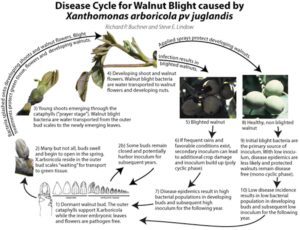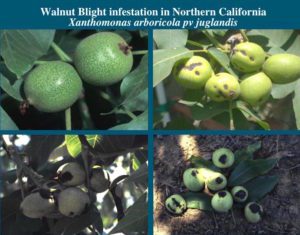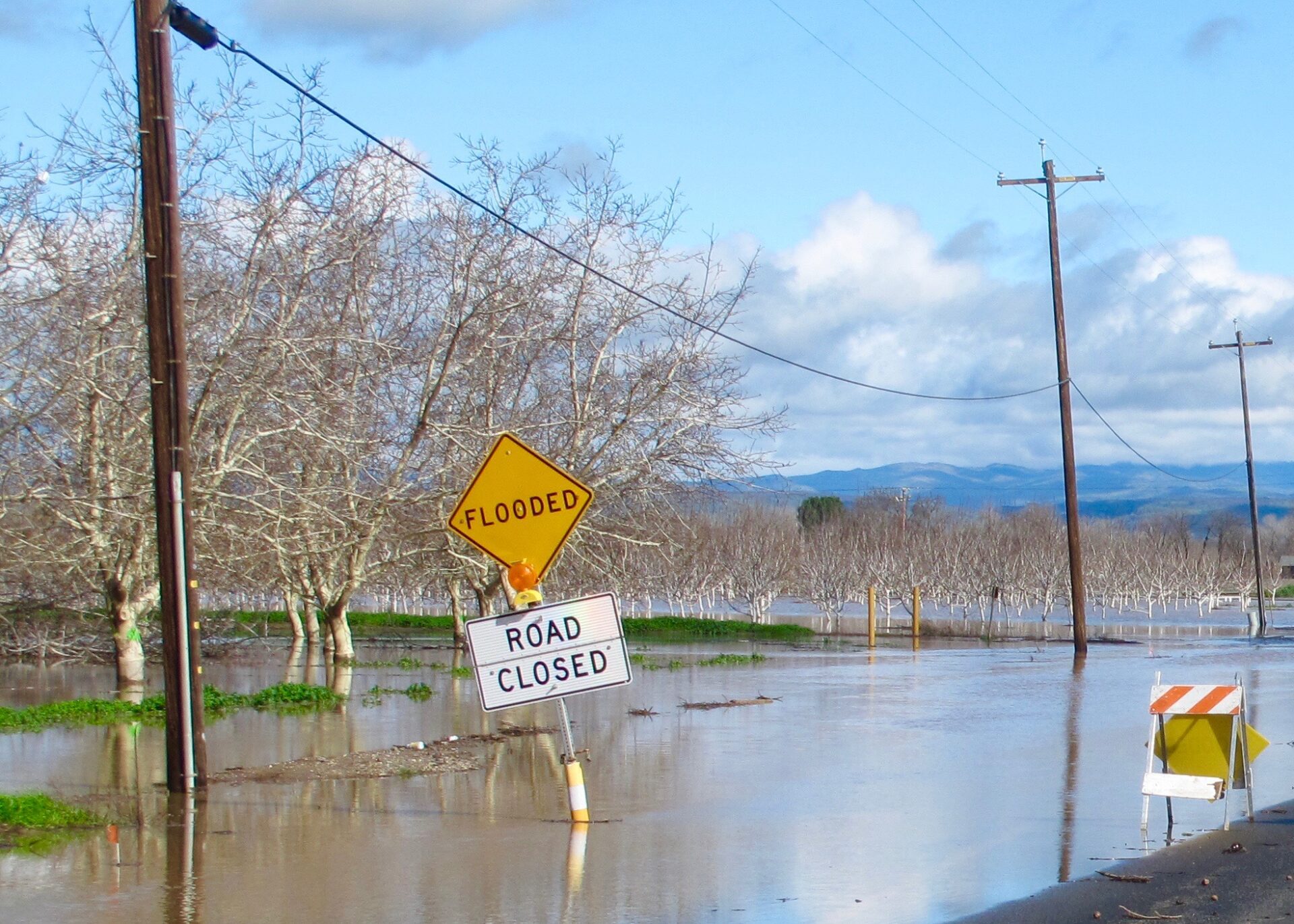Blight’s description “as any cause of impairment, destruction or ruin,” definitely applies to Xanthomonas arboricola pv juglandis (Xaj), a pathogen of Walnut Blight and the topic of Richard Buchner’s presentation during this year’s annual Walnut Trade Show hosted by West Coast Nut.
Buchner, UCCE Orchards Advisor, Tehama County, said walnut blight caused by Xaj can cause significant crop loss and determining an orchard’s risk is often a matter of guess work.
“Three things are necessary for the disease to occur,” he explained, “pathogen, host and favorable weather. This is often referred to as the disease triangle.”
One of Buchner’s “take home messages, is when it comes to walnut blight, the past few years drought and sunshine can be a benefit in controlling Xaj, while this year’s rainfall can increase the threat of the disease.
“Beware, once the rain events start to come in,” he said, “and these bacteria start building up, you are going to see increasing pressure and you need to start thinking about not letting the disease build up to high levels in orchards, which in turn makes control relatively difficult.”
Along with the moisture, the disease also prefers, and benefits from warm weather.
Buchner said if growers can reduce or eliminate any leg of the disease triangle, it can greatly result in reduction in damages.
“Back when I first started working on blight some 30 years ago, those of you who can remember, we were looking at blight damage numbers somewhere in the 60 to 70 percentiles. That was when we had resistance to copper and before we understood the chemistries. It was able to run away from us,” he shared. “Since that time, research and technology has saved a lot of crop.”
The disease cycle begins with dormant walnut bud. The outer cataphylls support the bacteria, while the inner embryonic leaves and flowers are pathogen free.
As the shoot grows through the infected outer bud scales, bacteria have the opportunity to move or be transported through rainfall, heavy dew or otherwise wet conditions, and infect developing leaves, shoots and flowers.
During research in Tehama County, untreated trees under simulated, plus natural rainfall were found to have 32 percent blighted walnuts in the mid-canopy and almost 70 percent on walnuts reachable from the ground.
The probability of infection depends upon how much pathogen exists on individual buds and environmental conditions favoring bacterial spread and infection.
“Some buds remain closed and potentially harbor inoculum for subsequent years,” Buchner explained. “If frequent rains and favorable conditions exist, secondary inoculum can lead to additional crop damage and inoculum build up.”
Disease epidemics result in high bacterial populations in developing buds and subsequent high inoculum for the following year.
Buchner said all green tissue is susceptible to Xaj, shoots, catkins, leaves and nuts, resulting in crop damaging black lesions.
“Nut infections are the most economically damaging because it is the nuts that we sell,” he added. “Early infections invade and kill the developing kernel and kill as they go. The tissue is destroyed and the nuts fall off the tree. The later infections, more common where we get a little bit or rain up in the north end of the state, maybe as late as June, nuts are pretty well formed by then and Xaj don’t usually invade and kill the kernel, but do become a problem with bridging for other pests to get in, not only Navel orange worm, but also cottling moth and some other fungi infections are piggy-backing.”
The whole “secret to this game” of breaking the walnut blight cycle, according to Buchner, is to protect the green tissue, and to protect it early to prevent the development of infection in the walnut, and decrease as much as possible the bacteria over-wintering in the buds.
“The probability of infection depends on how much disease risk you have, so the more and more disease that is building up and over-wintering on a tree and its dormant buds, the higher your probability is of getting an infection that is going to result in economic damage and the more difficult it is going to be to control the disease,” he emphasized.
Measuring walnut blight risk involves accessing an orchard’s previous history and measuring dormant bud populations.
“Strategy is two point; keep the amount of inoculum down, and early spraying to protect developing green tissue and nuts. One of the problems is that the amount of inoculum you are trying to control is a moving target,” he said. “A lot depends, in reference to your blight control with the weather and the inoculum, is how all the stars line-up so to speak, in terms of actual infection from year to year.”
With this year’s wet winter, growers are going to see an increase in disease pressure as a function of the weather and depending on how good, or bad, spray programs are carried out.
“If you got clobbered with walnut blight last year, you probably have a lot of inoculum and you will probably get clobbered again,” Buchner said. “But it you want to get real sciencey and sneaky, there are techniques of actually sending sample buds to labs and they will actually come back and tell you what your potential of infection is.”
For those wanting to go that route, see article graphic: Walnut Blight Bud Sampling.

DISEASE CONTROL
The right spray and spray timing are key strategies in blight control.
“The bulk of the disease’s damage occurs between mid-April to about the middle of May when it is starting to level out,” Buchner explained. “That is about when it is going to do what it does, and is causing the majority of its damage.”
He said it is suggested growers put the first spray on when 40 percent of the trees have buds that are opening and the shoots are elongated, or at the “prayer stage” since the unfolded leaves resemble praying hands, or, as Buchner puts it, growers are praying this first stage in the blight management process works.
“Often I will have growers spray when 20 percent of the buds are opening if the pressure of disease is high,” he added. “This places a protective layer of bactericide on leaf tissue. If bacteria are splashed from the outer bud scales to developing shoots and flowers, the bactericide barrier prevents infection and subsequent blight lesions. Early sprays are really the secret to controlling walnut blight.”
A second spray is applied about 7 to 10 days later to protect the remaining opening buds. Additional spray decisions are based upon measurements of infected buds, disease history, weather conditions and variety. This second spray backs up the first spray and protects the later opening buds which haven’t seen any copper spray.
At times, there may be a need for a third spray, depending on weather, pressure, history, climate, and inoculum levels, according to Buchner.

“The take home message here is that the most important flower buds are the ones that come out early. They have the highest probability of developing crop for you and are the most important to protect,” he added. “Spray well and spray early.”
Buchner and fellow researchers said many growers wonder if they need to blight spray Chandler or other late leafing varieties. They measured over 50 percent crop damage on Chandler walnuts when overwintering bud populations were high and spring weather favored disease. Conversely, they measured little to no blight on Chandler walnut with low to zero overwintering bud population levels even when wet spring weather favored disease.
The researchers found late leafing walnut varieties have less opportunity time to build high walnut blight populations. This does not eliminate, but reduces the probability of disease incidence. A good late leafing strategy would be to apply the first two spray applications with the intention of maintaining low inoculum levels.
What to Spray
Copper tank mixed with an EBDC (Ethylene Bisdithiocarbamate) such as Manzate flowable or Pro-stick is currently the most effective spray choice.
“Our conclusion is that just about any good quality copper products work fine and are all effective for controlling walnut blight,” Buchner said.
Follow label rates because metallic rates and copper availability vary depending upon product. Full coverage at full material rates is recommended.
Remember, it takes at least two years of a very good spray program to drive the disease back down.
“Also, remember it is about coverage, coverage, coverage at full spray,” Buchner advised. “There may be many variables in blight management, but this is a sure thing.”











